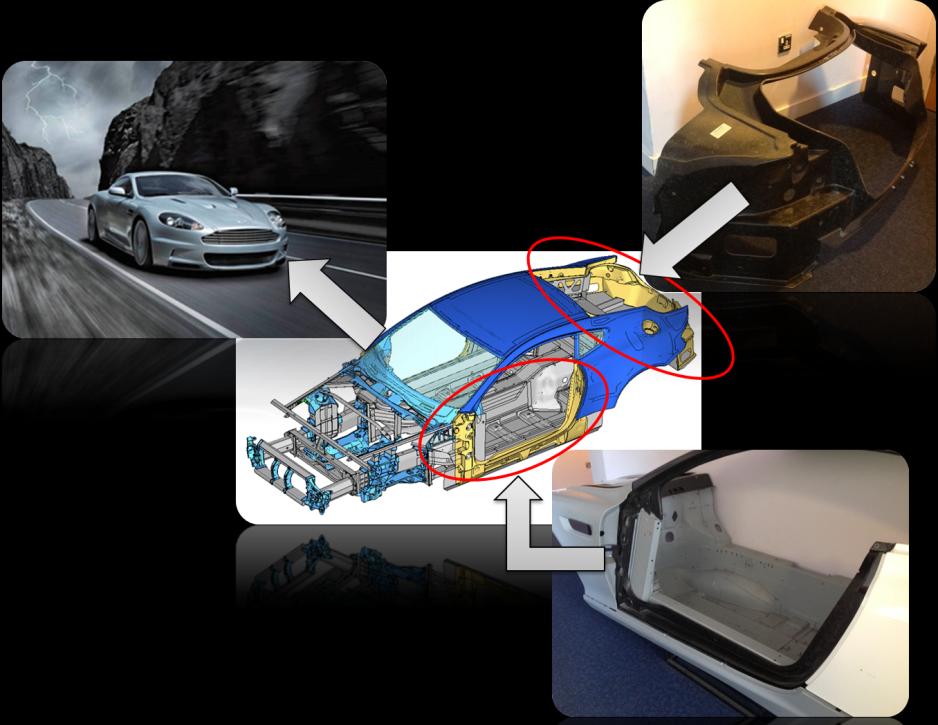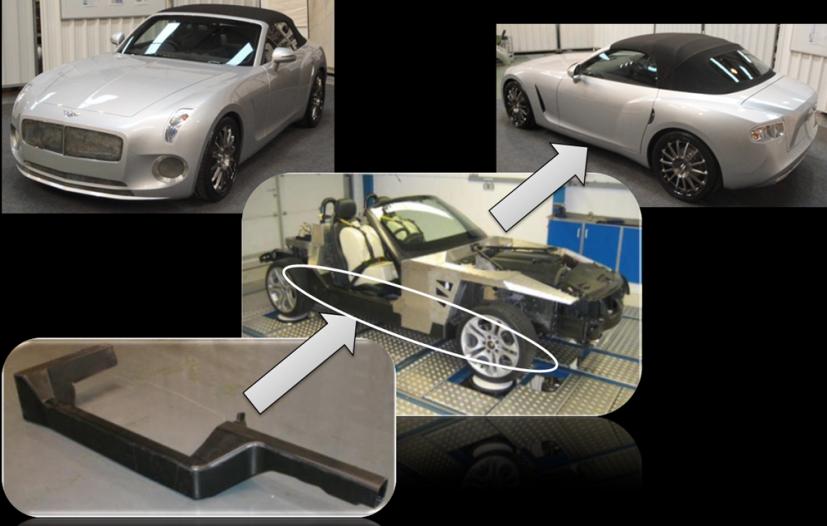Development of a novel carbon fibre manufacturing process for high performance automotive applications
Submitting Institution
University of NottinghamUnit of Assessment
General EngineeringSummary Impact Type
TechnologicalResearch Subject Area(s)
Engineering: Aerospace Engineering, Manufacturing Engineering, Materials Engineering
Summary of the impact
Underpinned by research at the University of Nottingham, the development
of automated
discontinuous carbon fibre preforming (DCFP) technology has helped drive
more than half a billion
pounds in sales of Aston Martin's DBS sports car across 42 countries,
boosting the company's
brand worldwide. Recognising the potential of this process, Bentley Motors
invested £1.3M directly
to develop this technology for its next generation of models. The Royal
Academy of Engineering
acknowledged the body of research as an "outstanding" contribution to the
reputation of British
engineering through the award of a silver medal to Professor Warrior.
Underpinning research
Increasingly stringent emissions targets are pushing vehicle
manufacturers to find novel ways of
reducing vehicle mass. A fall in the cost of carbon fibre has increased
the viability of using carbon-
based body panel systems as a cost-effective, lightweight alternative to
steel in order to improve
fuel consumption. Research carried out at the University of Nottingham
(UoN) from 2003 set out to
demonstrate that carbon fibre composites are suitable materials for the
high-volume production of
vehicles.
The UoN team, headed by Nick Warrior (Professor of Mechanical
Engineering, 1989 - present) and
Chris Rudd (Professor of Mechanical Engineering and Pro Vice-Chancellor,
1989 - present), began
by investigating how the established Ford Programmable Preform Process
(F3P) — a process that
fabricates vehicle parts from lightweight and strong glass fibre
composites, could be translated to
carbon fibre preforms.
Using F3P, a robot sprays the glass fibres on to a screen. The material
is consolidated with an
upper screen to form a preform in the shape of the vehicle part. However,
this process was not
directly transferable to carbon fibre composites. Glass fibre preforming
is facilitated by a special
form of glass fibre roving that has characteristics that make it suitable
for automated processing.
Similar product forms are not available for carbon fibre, as the
production volumes do not warrant
costly fibre modifications. Various technical issues related to the fibre
handling and placement also
had to be solved to allow processing of off-the-shelf carbon fibres. In
addition, the modelling of the
manufactured carbon fibre parts posed major challenges, as there is
significant heterogeneity in
the fibre architecture.
Using experimental and numerical techniques, Warrior and Rudd carried out
a range of simulations
and analyses to develop scientific understanding in two key areas.
Firstly, work on benchmarking
carbon body panel systems, carried out from 2002 to 2008, focused on the
comparison of DCFP
with commercial body panel systems [2.1] and the design of an optimal body
panel system.
Secondly, from 2006 to 2009, processing studies were carried out to
support carbon DCFP
manufacture, including analysis of microstructural parameters [2.2], the
effects of fibre length [2.3]
and filamentisation [2.4], permeability and resin injection simulation
[2.5] and fibre alignment [2.6].
The research concluded that carbon fibre composite structures could make
mass-produced
vehicles up to 50% lighter while still maintaining crash-test performance.
From 2004 to 2012 the
team developed the carbon DCFP process and commissioned a DCFP machine at
UoN, the first of
its kind in Europe. A four-stage process was established, comprising
spraying, heating, cooling and
preform extraction. During spraying, carbon fibre yarns (tows) are chopped
and sprayed on to a
perforated tool where a vacuum holds the desired pattern and shape of
fibres.
The work at Nottingham moved on to property prediction of the DCFP and
developing an in-depth
understanding of the material and how different fibre architectures
perform. This succeeded in
aiding the design of new components and identifying improvements in the
overall design process,
which in turn led to the creation of an Aston Martin technology
demonstrator. It was subsequently
deployed at tier one supplier SOTIRA (now part of France-based SORA
Composites) and
ultimately allowed Aston Martin to apply carbon fibre technologies to the
door opening
reinforcement and the trunk lid surround components on its DBS sports car.
The DCFP technology is being developed further as part of the EPSRC
Centre for Innovative
Manufacturing in Composites at Nottingham.
References to the research
References (Items marked with an asterisk indicate 3 most significant
papers):
2.1 *Turner, T.A., Harper, L.T., Warrior, N.A. and Rudd, C.D., 2008,
Low-cost carbon-fibre-based
automotive body panel systems — a performance and manufacturing cost
comparison, Journal
of Automobile Engineering — Proceedings of the Institution of Mechanical
Engineers Part D,
Volume 222, Issue 1, 53-64 DOI: 10.1243/09544070JAUTO406:
2.2 *Harper, L.T., Turner, T.A., Warrior, N.A., Dahl, J.S. and Rudd,
C.D., 2006, Characterisation of
random carbon fibre composites from a directed fibre preforming process:
analysis of
microstructural parameters, Composites Part A: Applied Science and
Manufacturing, Volume
37, Issue 11, 2136-2147 DOI: 10.1016/j.compositesa.2005.11.014
• JS Dahl, Ford Motor Company, USA (owners of Aston Martin at that time)
2.3 *Harper, L.T., Turner, T.A., Warrior, N.A. and Rudd, C.D., 2006,
Characterisation of random
carbon fibre composites from a directed fibre preforming process: the
effect of fibre length,
Composites Part A: Applied Science and Manufacturing, Volume 37,
Issue 11, 1863-1878 DOI:
10.1016/j.compositesa.2005.12.028
2.4 Harper, L.T., Turner, T.A., Warrior, N.A. and Rudd, C.D., 2007,
Characterisation of random
carbon fibre composites from a directed fibre preforming process: the
effect of tow
filamentisation, Composites Part A: Applied Science and Manufacturing,
Volume 38, Issue 3,
755-770 DOI: 10.1016/j.compositesa.2006.09.008
2.5 Endruweit, A., Harper, L.T., Turner, T.A., Warrior, N.A. and Long,
A.C., 2008, Random
discontinuous carbon fibre preforms: permeability modelling and resin
injection simulation,
Composites Part A: Applied Science and Manufacturing, Volume 39,
Issue 10, 1660-1669 DOI:
10.1016/j.compositesa.2008.07.006, copy available on request.
2.6 Harper, L.T., Turner, T.A., Martin, J.R.B. and Warrior, N.A., 2009,
Fibre alignment in directed
carbon fibre preforms: a feasibility study, Journal of Composite
Materials, Volume 43, Issue 1,
57-74 DOI: 10.1177/0021998308098151
Grants:
• EPSRC CASE studentship on studying the durability of DCFP for high
performance structural
applications under severe conditions (extreme temperatures, fatigue etc)
(PI Warrior)
• Advanced Composites Truss Structures (ACTS), Feb 2008 - Sept 2011, TSB
project #100447,
Grant value £939k with Bentley Motors Limited (PI Long)
• Affordable Discontinuous Carbon Composites for Structural Automotive
Applications, Feb 2008
- July 2012, TSB project #100442, Grant value £1.8M with Aston Martin
Lagonda Ltd. (PI
Warrior)
• EPSRC Centre for Innovative Manufacturing in Composites, July 2011 -
June 2016,
EP/I033513/1, £5.9M (PI Long)
Research contracts and income from industry:
2.7 Directly sponsored project with Bentley Motors Ltd on Multiscale
Material Modelling of
discontinuous fibre composites (Total Value £698k), 2008-2011
Details of the impact
The discontinuous carbon fibre preforming process developed through
Warrior and Rudd's body of
underpinning research at UoN has made a significant contribution to the
economic competitiveness
of two of Britain's leading manufacturers of luxury vehicles, Aston Martin
Lagonda and Bentley
Motors, and in the process has showcased British engineering excellence.
Aston Martin employed the technique for the production of the door
opening reinforcement and the
trunk lid surround for its DBS, 12MY Virage, 13MY DB9 and new Vanquish
models [4.1]. For DBS
alone — since 2008 3,300 cars have been sold in 42 countries at around
£180,000 each, which
equates to sales revenue of £594M. In 2011 more than 80% of Aston Martin's
sales were to buyers
outside the UK [4.2]. This surpassed Aston Martin CEO Ulrich Bez's aim of
selling a third of the
company's cars in Europe and a third in America. By comparison, in 2000
the brand's annual sales
were 800 cars, of which 700 were sold in the UK [4.2].
The two carbon fibre parts are manufactured and supplied by Sora
Composites, which is based in
St Meloir, France. They represent a weight saving of 52% and 44%
respectively compared to the
alternative glass fibre materials. Over 23 tonnes of discontinuous carbon
fibre composite material
has reached the market through this process on the DBS alone. The
technology has been a key
enabler for reducing mass and therefore improving both performance and
economy — making the
car lighter, faster and stronger [4.1].
"The Discontinuous Carbon Fibre Preform (DCFP) work with the University
of Nottingham resulted
in the uptake of chopped carbon fibre composite technology into the Trunk
Lid Surround (TLS) and
Door Opening Reinforcement (DOR) panels of the DBS... These parts were
originally one of the
main differentiators between the top of the range DBS model and other
models in our range of
supercars... The technology has been a key enabler for reducing mass and
therefore improving
both performance and economy across our range of vehicles." Source: Roland
Snell, Aston Martin
[4.1]
 Figure 1: showing carbon fibre parts manufactured using DCFP and their
location on the automobile
Figure 1: showing carbon fibre parts manufactured using DCFP and their
location on the automobile
The successful development of DCFP by the University of Nottingham
convinced Bentley Motors
Ltd of the value of DCFP. A total investment of £800k ([2.7] and
contribution to studentships) was
made by Bentley Motors in developing an enhancement to the DCFP process —
in collaboration
with Warrior — that involved using carbon fibre in its least processed
form and spraying it with resin
into a mould, eliminating the need for heating and cooling [4.4].
UoN's work formed the basis of Bentley's RayCell technology, which
Bentley employed, through
investment of a further £500,000 in 2010, for the production of a
demonstration vehicle that
showcases the next generation of cars to be produced by the company [4.4].
The demonstration
vehicle specifically showed that it is possible for the carbon fibre
chassis rails to support the weight
of the vehicle [4.3].
"The Raycell technology developed at the University of Nottingham has
been used to develop the
composite elements for the demonstrator vehicle. The research has
indicated that it is feasible to
manufacture major structural elements in our next generation of cars using
carbon fibre in this
way." Source: Lee Bateup, Bentley Motors [4.4]
 Figure 2: carbon fibre chassis rails manufactured using the Raycell
concept and its
location on the Bentley T35 demonstration vehicle
Figure 2: carbon fibre chassis rails manufactured using the Raycell
concept and its
location on the Bentley T35 demonstration vehicle
The underpinning research led to Warrior receiving the Royal Academy of
Engineering's
prestigious Silver Medal in July 2009 for his "outstanding personal
contribution to British
engineering" — further evidence of the positive impact of the research on
the reputation of the
British engineering industry. On presenting the award, the RAE said the
research into carbon fibre
composites had "shown that mass-produced vehicles can be up to 50% lighter
and still maintain
crash-test performance using lightweight carbon fibre composites". It
added: "High material costs
and labour-intensive manufacturing have restricted composites to motor
sports and supercars until
now... [Warrior] has demonstrated that composites are now a legitimate
material for use in high-
volume production (up to 20,000 vehicles a year)" [4.5].
Sources to corroborate the impact
4.1 Roland Snell, Principal Engineer — Body Structures, Aston Martin
Lagonda Ltd
4.2 Press article regarding Aston Martin sales growth
http://europe.autonews.com/apps/pbcs.dll/article?AID=/20120226/ANE/120229916/1131/aston-martin-plans-double-digit-sales-growth#axzz2M0S6ajyf
4.3 RayCell Technology
http://www.innovate10.co.uk/uploads/02%20-%20AD%20-%2012%20October%20GRAND%20CHALLENGE%20Slides%20-%20FINAL.pdf
4.4 Lee Bateup, New Technologies/Processes and Properties Manager,
Concept Engineering,
Bentley Motors Ltd
4.5 Press release regarding award of Royal Academy of Engineering Silver
Medal
http://www.raeng.org.uk/news/releases/shownews.htm?NewsID=509